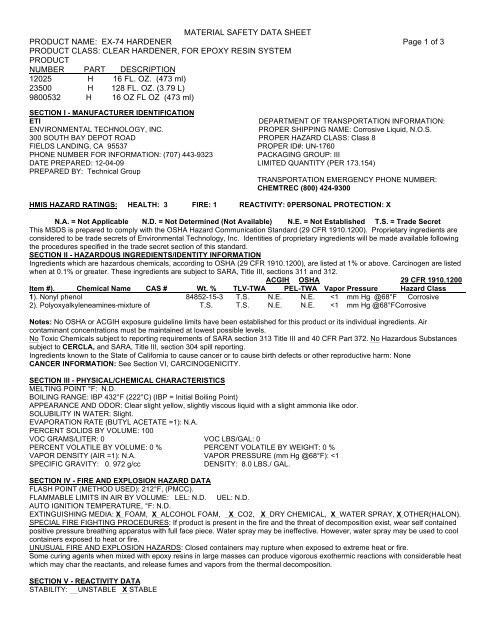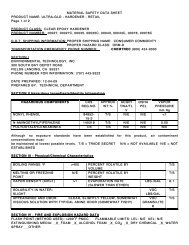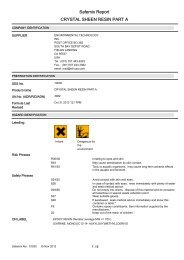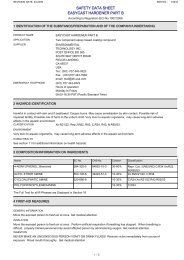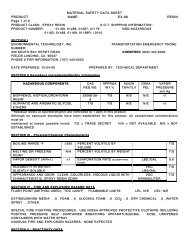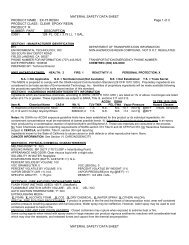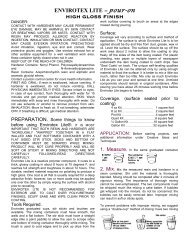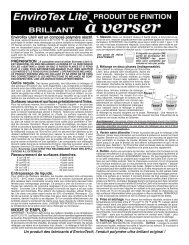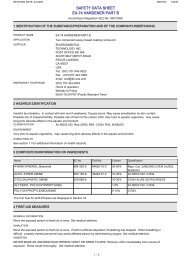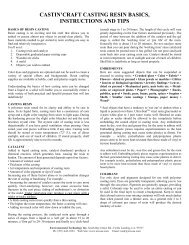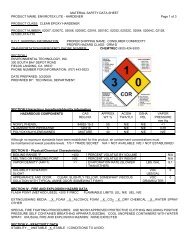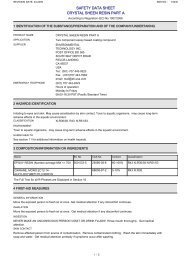MATERIAL SAFETY DATA SHEET PRODUCT NAME: EX-74 ...
MATERIAL SAFETY DATA SHEET PRODUCT NAME: EX-74 ...
MATERIAL SAFETY DATA SHEET PRODUCT NAME: EX-74 ...
You also want an ePaper? Increase the reach of your titles
YUMPU automatically turns print PDFs into web optimized ePapers that Google loves.
<strong>MATERIAL</strong> <strong>SAFETY</strong> <strong>DATA</strong> <strong>SHEET</strong><strong>PRODUCT</strong> <strong>NAME</strong>: <strong>EX</strong>-<strong>74</strong> HARDENER Page 1 of 3<strong>PRODUCT</strong> CLASS: CLEAR HARDENER, FOR EPOXY RESIN SYSTEM<strong>PRODUCT</strong>NUMBER PART DESCRIPTION12025 H 16 FL. OZ. (473 ml)23500 H 128 FL. OZ. (3.79 L)9800532 H 16 OZ FL OZ (473 ml)SECTION I - MANUFACTURER IDENTIFICATIONETIDEPARTMENT OF TRANSPORTATION INFORMATION:ENVIRONMENTAL TECHNOLOGY, INC.PROPER SHIPPING <strong>NAME</strong>: Corrosive Liquid, N.O.S.300 SOUTH BAY DEPOT ROAD PROPER HAZARD CLASS: Class 8FIELDS LANDING, CA 95537PROPER ID#: UN-1760PHONE NUMBER FOR INFORMATION: (707) 443-9323PACKAGING GROUP: IIIDATE PREPARED: 12-04-09 LIMITED QUANTITY (PER 173.154)PREPARED BY: Technical GroupTRANSPORTATION EMERGENCY PHONE NUMBER:CHEMTREC (800) 424-9300HMIS HAZARD RATINGS: HEALTH: 3 FIRE: 1 REACTIVITY: 0 PERSONAL PROTECTION: XN.A. = Not Applicable N.D. = Not Determined (Not Available) N.E. = Not Established T.S. = Trade SecretThis MSDS is prepared to comply with the OSHA Hazard Communication Standard (29 CFR 1910.1200). Proprietary ingredients areconsidered to be trade secrets of Environmental Technology, Inc. Identities of proprietary ingredients will be made available followingthe procedures specified in the trade secret section of this standard.SECTION II - HAZARDOUS INGREDIENTS/IDENTITY INFORMATIONIngredients which are hazardous chemicals, according to OSHA (29 CFR 1910.1200), are listed at 1% or above. Carcinogen are listedwhen at 0.1% or greater. These ingredients are subject to SARA, Title III, sections 311 and 312.ACGIH OSHA 29 CFR 1910.1200Item #). Chemical Name CAS # Wt. % TLV-TWA PEL-TWA Vapor Pressure Hazard Class1). Nonyl phenol 84852-15-3 T.S. N.E. N.E.
<strong>MATERIAL</strong> <strong>SAFETY</strong> <strong>DATA</strong> <strong>SHEET</strong><strong>PRODUCT</strong> <strong>NAME</strong>: <strong>EX</strong>-<strong>74</strong> HARDENER Page 2 of 3CONDITIONS TO AVOID: Strong oxidizing chemicals, strong mineral and organic acids, sustained direct open flames and hot surfaces.When product is mixed with Part A and left in a large mass a vigorous exothermic reaction may occur, and may result in charring of thereactants. Read and follow all instructions. Do not add nitrites, may form suspected cancer causing nitrosamines.HAZARDOUS DECOMPOSITION OR BY<strong>PRODUCT</strong>S: Carbon monoxide, carbon dioxide, phenol, ammonia, oxides of nitrogen, andvarious amine containing compounds. Irritating aldehydes and ketones may be formed on burning in limited air supply.HAZARDOUS POLYMERIZATION: MAY OCCUR X MAY NOT OCCUR.CONDITIONS TO AVOID UNCONTROLLED POLYMERIZATION: N.A.SECTION VI - HEALTH HAZARD <strong>DATA</strong>The health effects noted below are consistent with requirements under the OSHA Hazard Communication Standard (29 CFR1910.1200).HEALTH HAZARD WARNING STATEMENTS:DANGER! CORROSIVE, AVOID CONTACT WITH EYES AND SKIN. CAUSES EYE AND SKIN BURNS. HARMFUL IF ABSORBEDTHROUGH THE SKIN. DO NOT TAKE INTERNALLY. HARMFUL OR FATAL IF SWALLOWED. ASPIRATION HAZARD IFSWALLOWED- CAN ENTER LUNGS AND CAUSE DAMAGE. USE ONLY IN ADEQUATE VENTILATED AREAS. AVOID BREATHINGVAPORS OR MIST. CAUSES MUCOUS MEMBRANE AND RESPIRATORY TRACT IRRITATION. DO NOT ADD NITRITES-MAYFORM SUSPECTED CANCER CAUSING NITROSAMINES. KEEP AWAY FROM CHILDREN. WASH WITH SOAP AND WATERAFTER USE.ROUTE(S) OF ENTRY: INHALATION, SKIN CONTACT, EYE CONTACT, INGESTION.SIGNS AND SYMPTOMS OF OVER<strong>EX</strong>POSURE :INHALATION: Irritation, coughing, nasal discharge, with possible breathing difficulties. Possible blurred or hazy vision.SKIN CONTACT: Irritation with pain, redness and swelling with chemical burns.EYE CONTACT: Irritation with pain, redness, and eye watering with chemical burns. Severe eye damage may causeblindness.INGESTION: Irritation with pain to mouth, throat, abdominal and chest. Nausea, vomiting, diarrhea, thirst, weakness,and collapse. Aspiration (liquid enters the lungs) of vomit can cause lung damage.EMERGENCY AND FIRST AID PROCEDURES :Never give anything by mouth to an unconscious or convulsing person.EYE CONTACT: Remove any contact lenses and flush for 15 minutes with potable water. Hold eyelids open to assurecomplete flushing. Do not attempt to neutralize with chemical agents. CALL A PHYSICIANIMMEDIATELY. Repeat 15 minute water flush if medical attention is not immediately available.SKIN CONTACT: Remove contaminated clothing/shoes and wipe excess from skin. Flush skin with water for 15 minutes.Do not attempt to neutralize with chemical agents. DO NOT USE SOLVENTS TO REMOVE HARDENERFROM SKIN. Follow by washing with soap and water. GET MEDICAL ATTENTION. Do not reuseclothinguntil cleaned. Contaminated leather articles, including shoes, cannot be decontaminated andshould bedestroyed to prevent reuse.INHALATION: Leave the area to obtain fresh air. If breathing has stopped, give artificial respiration thenoxygen if needed. If difficulty breathing or other symptoms continue, CALL A PHYSICIANIMMEDIATELYINGESTION: DO NOT INDUCE VOMITING, THIS <strong>MATERIAL</strong> IS CORROSIVE. If patient is conscious, give twoglasses, (12-16 oz.) of water for dilution effect only. Do not induce vomiting. If vomiting occurs, givewater again. CALL A PHYSICIAN IMMEDIATELY, or the Poison Control Center. Do not give anything bymouth to an unconscious or convulsing person.IF ANY SYMPTOMS PERSIST CONTACT A PHYSICIANHEALTH HAZARD, ACUTE:INHALATION: Inhalation of vapors may cause irritation to the respiratory tract. Prolonged orrepeated exposure may cause lung damage.SKIN CONTACT: Irritation, tissue damage, and dermatitis. Skin absorption may cause other adverse effects listed.EYE CONTACT: Primary irritant. Cornea damage possible. Severe eye damage may cause blindness.INGESTION: Irritation to gastrointestinal tract. Severe ulceration, inflammation, and possible perforation of the upperalimentary tract, with hemorrhage and fluid loss. Aspiration (liquid enters the lungs) of vomit cancauselung damage.HEALTH HAZARDS, CHRONIC, (TARGET ORGANS): Repeated skin contact may cause persistent irritation or dermatitis. Repeatedinhalation may cause lung damage.CARCINOGENICITY: For hazard communication purposes under OSHA standard 29 CFR part 1910.1200. None of the productsingredients is found on the following lists.NTP: No IARC: No Federal OSHA: No
<strong>MATERIAL</strong> <strong>SAFETY</strong> <strong>DATA</strong> <strong>SHEET</strong><strong>PRODUCT</strong> <strong>NAME</strong>: <strong>EX</strong>-<strong>74</strong> HARDENER Page 3 of 3MEDICAL CONDITIONS GENERALLY AGGRAVATED BY <strong>EX</strong>POSURE: Persons with pre-existing lung disorders may be moresusceptible to irritating effects. Pre-existing skin and eye disorders may be aggravated by exposure to this product.SECTION VII -SPILL, LEAK, AND DISPOSAL PROCEDURESSTEPS TO BE TAKEN IF <strong>MATERIAL</strong> IS RELEASED OR SPILLED: Evacuate area. Eliminate sources of ignition. May burn althoughnot readily ignitable. Use Protective equipment and respiratory protection as stated in Section VIII. Contain liquid or contaminated washwater spills using a barrier of inert material such as sand or by diking the area. Absorb spilled or contaminated wash water with an inertmaterial. Scoop or shovel absorbed material into containers for disposal. Prevent spilled product or contaminated wash water fromentering drinking water supplies, streams, or sewers. Certain releases of any substance to the environment are prohibited by law andmay require reporting to an environmental agency.WASTE DISPOSAL METHOD: This product does not meet criteria of a hazardous waste under RCRA if discarded as this product issupplied. Under RCRA, it is the responsibility of the user of products to determine, at the time of disposal, whether product meetsRCRA criteria for hazardous waste. No disposal method should be used which would pose an environmental or human health threatincluding any which would contaminate ground or surface waters. Dispose of waste in accordance with local, state, and federalregulations. Canada: Dispose of waste in accordance with local, provincial and national regulations.SECTION VIII- PRECAUTIONS FOR SAFE HANDLING AND USEPRECAUTIONS: USE ONLY IN VENTILATED AREAS. Minimum feasible handling temperatures should be maintained. Hardener, PartH recommended handling temperature is 68°F or below to reduce vapors and maintain working time. This material should be confinedas far as possible within sealed or covered equipment in which case normal ventilation should be adequate. To avoid breathing vaporsduring mixing, application and the drying process use local exhaust ventilation or other means to provide fresh air, opening windowsand doors to achieve cross-ventilation. Air contaminant concentrations must be maintained at lowest possible levels. Close containerafter use, and store in upright position in a cool, dry, and well ventilated area. Periods of exposure to high temperatures should beminimized. Water contamination should be avoided. If stored above 100°F, a nitrogen atmosphere is recommended.OTHER PRECAUTIONS: “Empty” containers contain product residue (liquid and/ or vapor). Dispose of properly. Dust from sanding dryfilms should be treated as nuisance dust, TLV of 10 mg /Cu. meter.MECHANICAL (GENERAL) VENTILATION: Provide sufficient mechanical ventilation to remove vapors. Since no limits have beenestablished for this product or its individual ingredients, air contaminant concentrations must be maintained at lowest possible levels.The need for fume hoods, local exhaust, or spray booths should be considered for commercial operations.SPECIAL VENTILATION: Local exhaust if necessary to ventilate spill area, or where product is heated.RESPIRATORY PROTECTION: Respiratory protection is not ordinarily required in ventilated area. Respiratory protection is required inthe absence of proper environmental control. Use an approved air purifying ORGANIC VAPOR RESPIRATOR, (type NIOSH/MSHATC-23C), or positive pressure self-contained breathing apparatus, SCBA, when products are: used in confined or poorly ventilatedareas, or at elevated temperatures.PROTECTIVE GLOVES: Chemical impervious rubber or nitrile gloves are recommended. Avoid ALL skin contact.EYE PROTECTION: Avoid contact with eyes. Approved safety glasses with splash guards or goggles are required.OTHER PROTECTIVE CLOTHING OR EQUIPMENT: Impervious clothing, foot ware, and synthetic apron to prevent skin contact arerecommended. Provide nearby safety showers and eye washing (preferably full face) facilities.WORK/HYGIENIC PRACTICES: Wash thoroughly after handling. Clean up spills. Wash contaminated clothes before reuse. Launderwork clothes separate from family clothes. Contaminated leather articles, including shoes, cannot be decontaminated and should bedestroyed to prevent reuse. Check protective equipment and clothing before use.Disclaimer: All information, recommendations, and suggestions appearing herein concerning our product are based upon tests anddata believed to be reliable. However, it is the user's responsibility to determine the safety, toxicity, and suitability for his or her ownuse of the product described herein. Since the actual use by others is beyond Environmental Technology, Inc.'s control, no guarantee,expressed or implied, is made by Environmental Technology, Inc. as to the effects of such use, the results to be obtained, or the safetyand toxicity of the product.


